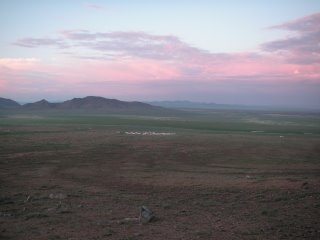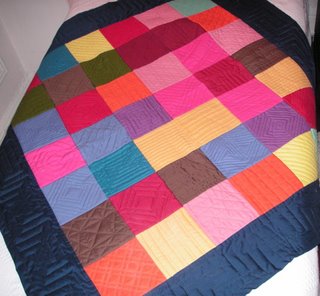
One of the few One Patch Quilts I've made, this was finished this summer and took about two years to make ... because it's not as simple as it looks. Each patch is hand quilted in a pattern of straight lines, none of the 54 squares have the same pattern. Color and layout were inspired, though I didn't try for an exact copy, by an Ellsworth Kelly painting ... I was attracted by the "Amish" colors, and had a good selection of them in my stash.
This is not "typical" of my quilts ... well, I don't think I have a typical style. But I do like simplicity that isn't as simple as it first appears. It is lap size and is keeping my toes warm as I type. It took a couple of years because I did the hand quilting only during bus rides -- mainly going to Cape Cod to visit Rachel and family. Also I sewed in the evenings when I was reading and had WQXR, the classical music station, on and heard they were going to play something I especially like and wanted to listen to with [almost] full attention -- not the partial attention of reading at the same time. Hand quilting when lines are already marked is rote work, not thinking work. So all the stitches in the squares are happy time work, peaceful [pun! as if you didn't get it] work.
I start with this quilt for another reason and call it "Four Square Quilt" because it echoes my actual start in life. I was born in a little four square house on a little square 40 acre farm out in that part of the Midwest where surveyors laid out the land for settlers in mile square grids. Those grids were divided into plots, the smallest usually was 40 acres. Which was all my parents, as recent newly weds at the end of the depression, could afford.
A four-square house [still a recognized architectural form] is one that is square [surprise!]; within it the rooms are all squares of exactly the same size. What could be simpler? These houses often have a porch along the front and sometimes a structure against the back -- ours had a narrow, full length front orch and a shed at the back. The farm had a number of other building, a big [it seemed] barn, and a grainary, a "summer house" with a cellar for root vegetables and canned goods, and there was an outhouse, of course, also a chicken house and pig stye and spring house for keeping milk cool until it was picked up by the dairy truck. A little later my father built a garage.
I was born, literally, in that house. As was my m brother 22 months later. We lived there until the summer I turned eleven. In the post-war prosperity my father was able to buy a 100 acre farm a mile away and build a bigger house and two barns. I have the kind of visual memory that doesn't forget places and orientations. I remember where every bit of furniture was in that first house -- the second house too -- and I could draw a diagram of it as well as of the entire farm with considerable detail
So this is to say that squares, grids are a deep part of my psychic orientation in the world ... this may explain some of the pleasure I get from quilting, especially quilting that uses block formation -- and especially with some complication within the blocks. Grids are comforting because you know where you are. Thus, living now in New York City the girds above Houston make address finding easy and I get disoriented further downtown where the streets follow older patterns. On the other hand girds are confining and utterly unnatural on the landscape. But humans enjoys geometry -- certainly I enjoyed it in high school. Geometry goes back to early civilizations. I don't think many ancient cities were laid out on girds but when Zoser and Cheops wanted fine monuments, they built pyramids. So did the Mexicans and the Mayas, as had the Hopewell peoples of the Ohio River Valley -- not many people know that the American Midwest was once dotted with pyramids. Like much else Native Ameican, we invaders destroyed nearly all of them.

Where there are no grids a feeling of freedom and excitement quickens the heart. This is almost impossible in the United States for the country was symstematically spider webbed with asphalt and concrete during the last two-thirds of the 20th century, all for the sake of the automobile. I think I read that someting like 14% of the US has been paved! Well, if it was only 4%, that's still a lot of open nature that has been 'disappeared" for the sake of gas guzzling, carbon monoxide spewing machinery. I had never experienced the freedom of roadless space until I was in the Sahara -- and not very deep into it at that. Last summer in Mongolia, both in the steppes and in the Gobi I understood spaciousness in a way different from but yet analogous to the spaciousness I had discovered trekking in roadless parts of Nepal.
I realized that the visceral feeling of freedom -- and of smallness -- in vast roadless spaces is something very few people from the crowded countries ever experience. Being "off the grid" is liberating to body and mind. I imagine people who sail the ocean in small ships experience this also. Those who never experience it has missed a sense of nature that changes the way you look at the world.
So, how did I get from quilting and being born in a tiny four-square house to this discovery of open space? Well, it took most of my life, it was a journey, it was complicated. Quilting, as I wrote, can be routine, and that leads to meditation ... so this blog will be a series of both regular observations and meditations, about the craft, about my life, and about life in general. Enough for a start,







No comments :
Post a Comment